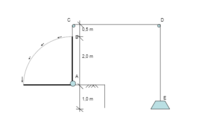Student_needs_help
New member
- Joined
- Apr 1, 2019
- Messages
- 10
I need the answer and equation if someone can help, because i am lost on this one.
In the accompanying figure, AB is a rigid rod in an upright position and at its end B is a flexible rope that rotates through point-like rollers at C and D to E, where a weight is attached to the rope. How much does the weight at step E rise when the rod AB is pivoted into the pan?
In the accompanying figure, AB is a rigid rod in an upright position and at its end B is a flexible rope that rotates through point-like rollers at C and D to E, where a weight is attached to the rope. How much does the weight at step E rise when the rod AB is pivoted into the pan?

